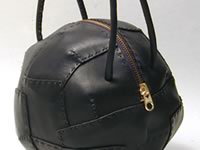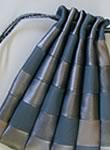
|
| Beautifully crafted UMAMI BAGS -- absolutely one of a kind Yoshimi
Ezura started making her bags about twenty years ago, as she was
totally fascinated with the quality the leather possessed. To the
question, “what do you love about leather?” Her reply is very simple,
”I love leather because it doesn’t fray! Unlike fabric, you don’t
have to worry about clipping the loose strands, no matter whether
it is soft leather or tough leather.” In feature 006, we will introduce
you Yoshimi Ezura, a leathercraft artist who has excellent ability
to handle leather, and also introduce you to her handsome bags.
|
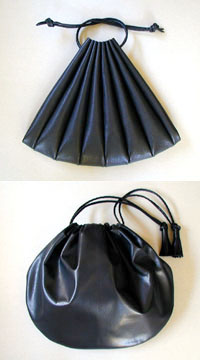 |
Oh!
That’s an Umami Bag! Only once a year does Ezura hold a solo exhibition of her leather works. The exhibit displays the collection of her selected one of a kind bags. I asked why she makes only one of each design? She explains, “the reason is because during the process of making one, new ideas pops in my mind for my next design and I do not want to spend time repeating the process of making the same bag again”. She spends the entire year making creations for her annual exhibition, and one can only buy her bags during this exhibition. This is what I call a genuine, one of a kind. She explains, “In the past, I had contracted work outside, to see if I could produce in quantity, but I gave up that idea. I felt I could only be fully satisfied with my works, by actually doing the job myself from start to finish.” She smiles, and adds, “I intend to continue making one of a kind bags”. Even though they are such rare leather bags, when one sees someone walking in the city holding her bag, it is immediately recognizable -- “Oh! That’s an Unami Bag!”. It is not a Hermes, Gucci, or a Kelly bag, but a distinctive Umami bag. Ezura’s inspirations, her treatment of the leather, her skills in handling the leather--- all these individual component play an important role to create the final outcome. The correct blend of form, the color and thickness of the leather, the way it is finished—all of these produce the total design of each strikingly attractive bag. You can say that you have to be a lover of handmade craft to hold one of these bags, as it definitely has that warmth of the artisan’s work, which makes one smile and proud to own it, even if it may go unrecognized. |
|
|
A place for inspiration
|
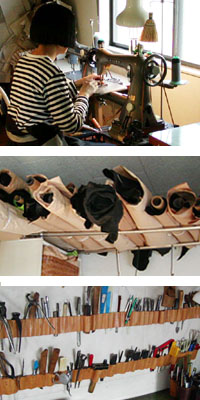
|
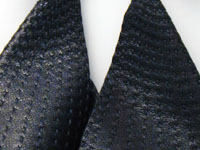 |
Stitches,
stitches, stitches In olden times, when the woven fabric was a luxury, for reinforcement, a cloth was sewn with cotton thread, vertically, horizontally, and diagonally, mainly on indigo dyed fabrics (Ai-zome). This is called “Sashiko”, a technique born from women’s wisdom wanting to prolong the wear of the farmer's working clothes. Applying these stitches on leather, the small stitches create small irregular surfaces, causing interesting bumpy reflections, and tactile impressions. |
| Knobby
knots The proper name “Sagara Stitches” is one of the traditional embroidery techniques for kimonos and obis, also often called “French Knots”. Knots are made and gathered together forming lumps on the leather. This technique was very popular in the Edo period to make pouches durable. These nodes accentuate the leather, and add much to the optical impression and give unique textures. |
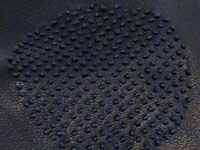 |
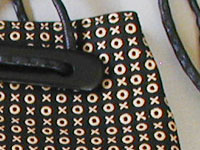 |
Inden Inden is the name of the technique that applies elaborate stenciled patterns with urushi lacquer on deerskin. It is one of the oldest traditional skills in Japan. In the past, these decorative deerskins were wrapped around the hilt of the sword, or were used to decorate weapons and armors of warlords. Today, the inden is mainly used as material to make handbags. Ezura has mastered using such traditional skills on her bags with a touch of contemporary look. |
| Projections,
protrusions Here and there dangles long strips of leather projecting from the bag surface. It seems as if, suddenly the smooth surface of the leather becomes alive, with its dangling arms swaying back and forth as you walk. |
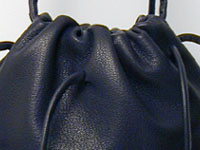 |
 |
Patches The surface of the leather is cut, and another piece of leather is loosely applied and sewn protruding from the holes. They look like sleeping caterpillar, waiting to become butterflies --there is something organic looking to the decorative patterns formed on the leather. |
|
Bamboo basket |
 |
Today,
with the business world moving 24-hours a day, some people must carry
their personal computers everywhere they go. Perfectly suited for
today’s multi-tasked women, these tote bags are very durable and lightweight,
excellent to hold your files and laptop computer in one sophisticated
package. |
| The base of these totes is 10 cm wide and, and sturdy to withstand some weight. They are just perfect to carry your tools, throw in your flowers after a flower arrangement (Ikebana) classes or papers after a calligraphy (Shodo) lessons. |
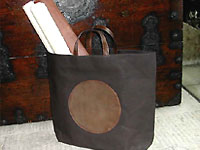 |
|
|
